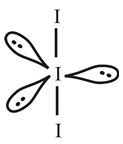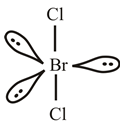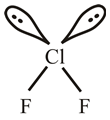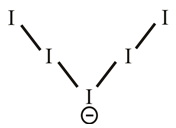
(a)
Interpretation: To draw the lewis dot structure and molecular structure of
Concept introduction:
A lewis dot structure is a diagram that show bonding between the atoms. A lewis dot structure is used to predict the geometry of the molecule.
A lewis dot structure is a two dimensional representation whereas a molecular structure is a three dimensional structure and many of the properties both chemical and physical are dictated by molecular structure.
Molecular geometry is the shape of a molecule predicted by considering only bond pair of electrons
Electron geometry is the shape of a molecule predicted by considering both bond electron pairs and lone pair of electrons.
According to VSEPR theory, the geometry is predicted by the minimizing the repulsions between electron-pairs in the bonds and lone-pairs of electrons. The VSEPR theory is summarized in the given table as,
(a)
Answer to Problem 78GQ
The lewis dot structure of

The molecular structure of

Explanation of Solution
The iodine atom belongs to group
The lewis dot structure of

The molecular structure of
The molecular structure of

(b)
Interpretation: To draw the lewis dot structure and molecular structure of
Concept introduction:
A lewis dot structure is a diagram that show bonding between the atoms. A lewis dot structure is used to predict the geometry of the molecule.
A lewis dot structure is a two dimensional representation whereas a molecular structure is a three dimensional structure and many of the properties both chemical and physical are dictated by molecular structure.
Molecular geometry is the shape of a molecule predicted by considering only bond pair of electrons
Electron geometry is the shape of a molecule predicted by considering both bond electron pairs and lone pair of electrons.
According to VSEPR theory, the geometry is predicted by the minimizing the repulsions between electron-pairs in the bonds and lone-pairs of electrons. The VSEPR theory is summarized in the given table as,
(b)
Answer to Problem 78GQ
The lewis dot structure of

The molecular structure of

Explanation of Solution
The bromine atom belongs to group
The lewis dot structure of

The molecular structure of
The molecular structure of

(c)
Interpretation: To draw the lewis dot structure and molecular structure of
Concept introduction:
A lewis dot structure is a diagram that show bonding between the atoms. A lewis dot structure is used to predict the geometry of the molecule.
A lewis dot structure is a two dimensional representation whereas a molecular structure is a three dimensional structure and many of the properties both chemical and physical are dictated by molecular structure.
Molecular geometry is the shape of a molecule predicted by considering only bond pair of electrons
Electron geometry is the shape of a molecule predicted by considering both bond electron pairs and lone pair of electrons.
According to VSEPR theory, the geometry is predicted by the minimizing the repulsions between electron-pairs in the bonds and lone-pairs of electrons. The VSEPR theory is summarized in the given table as,
(c)
Answer to Problem 78GQ
The lewis dot structure of

The molecular structure of

Explanation of Solution
The flourine atom belongs to group
The lewis dot structure of

The molecular structure of
The molecular geometry of

(d)
Interpretation: To draw the lewis dot structure and molecular structure of
Concept introduction:
A lewis dot structure is a diagram that show bonding between the atoms. A lewis dot structure is used to predict the geometry of the molecule.
A lewis dot structure is a two dimensional representation whereas a molecular structure is a three dimensional structure and many of the properties both chemical and physical are dictated by molecular structure.
Molecular geometry is the shape of a molecule predicted by considering only bond pair of electrons
Electron geometry is the shape of a molecule predicted by considering both bond electron pairs and lone pair of electrons.
According to VSEPR theory, the geometry is predicted by the minimizing the repulsions between electron-pairs in the bonds and lone-pairs of electrons. The VSEPR theory is summarized in the given table as,
(d)
Answer to Problem 78GQ
The lewis dot structure of

The molecular structure of

Explanation of Solution
The iodine atom belongs to group
The lewis dot structure of

The molecular structure of

Want to see more full solutions like this?
Chapter 21 Solutions
Chemistry & Chemical Reactivity
- 111 Carbonyl Chem Choosing reagants for a Wittig reaction What would be the best choices for the missing reagents 1 and 3 in this synthesis? 1. PPh3 3 1 2 2. n-BuLi • Draw the missing reagents in the drawing area below. You can draw them in any arrangement you like. Do not draw the missing reagent 2. If you draw 1 correctly, we'll know what it is. • Note: if one of your reagents needs to contain a halogen, use bromine. Explanation Check Click and drag to start drawing a structure. × ©2025 McGraw Hill LLC. All Rights Reserved. Terms of Usearrow_forwardA student proposes the transformation below in one step of an organic synthesis. There may be one or more reactants missing from the left-hand side, but there are no products missing from the right-hand side. There may also be catalysts, small inorganic reagents, and other important reaction conditions missing from the arrow. • Is the student's transformation possible? If not, check the box under the drawing area. . If the student's transformation is possible, then complete the reaction by adding any missing reactants to the left-hand side, and adding required catalysts, inorganic reagents, or other important reaction conditions above and below the arrow. • You do not need to balance the reaction, but be sure every important organic reactant or product is shown. + T X O O лет-ле HO OH HO OH This transformation can't be done in one step.arrow_forwardDetermine the structures of the missing organic molecules in the following reaction: X+H₂O H* H+ Y OH OH Note: Molecules that share the same letter have the exact same structure. In the drawing area below, draw the skeletal ("line") structures of the missing organic molecules X and Y. You may draw the structures in any arrangement that you like, so long as they aren't touching. Click and drag to start drawing a structure. X Sarrow_forward
- Predict the major products of this organic reaction. If there aren't any products, because nothing will happen, check the box under the drawing area instead. No reaction. HO. O :☐ + G Na O.H Click and drag to start drawing a structure. XS xs H₂Oarrow_forwardWhat are the angles a and b in the actual molecule of which this is a Lewis structure? H H C H- a -H b H Note for advanced students: give the ideal angles, and don't worry about small differences from the ideal groups may have slightly different sizes. a = b = 0 °arrow_forwardWhat are the angles a and b in the actual molecule of which this is a Lewis structure? :0: HCOH a Note for advanced students: give the ideal angles, and don't worry about small differences from the ideal that might be caused by the fact that different electron groups may have slightly different sizes. a = 0 b=0° Sarrow_forward
- Determine the structures of the missing organic molecules in the following reaction: + H₂O +H OH O OH +H OH X Note: Molecules that share the same letter have the exact same structure. In the drawing area below, draw the skeletal ("line") structure of the missing organic molecule X. Click and drag to start drawing a structure.arrow_forwardIdentify the missing organic reactant in the following reaction: x + x O OH H* + ☑- X H+ O O Х Note: This chemical equation only focuses on the important organic molecules in the reaction. Additional inorganic or small-molecule reactants or products (like H₂O) are not shown. In the drawing area below, draw the skeletal ("line") structure of the missing organic reactant X. Click and drag to start drawing a structure. Carrow_forwardCH3O OH OH O hemiacetal O acetal O neither O 0 O hemiacetal acetal neither OH hemiacetal O acetal O neither CH2 O-CH2-CH3 CH3-C-OH O hemiacetal O acetal CH3-CH2-CH2-0-c-O-CH2-CH2-CH3 O neither HO-CH2 ? 000 Ar Barrow_forward
- What would be the best choices for the missing reagents 1 and 3 in this synthesis? 1. PPh3 2 2. n-BuLi 3 Draw the missing reagents in the drawing area below. You can draw them in any arrangement you like. • Do not draw the missing reagent 2. If you draw 1 correctly, we'll know what it is. • Note: if one of your reagents needs to contain a halogen, use bromine. Explanation Check Click and drag to start drawing a structure.arrow_forwardPredict the products of this organic reaction: NaBH3CN + NH2 ? H+ Click and drag to start drawing a structure. ×arrow_forwardPredict the organic products that form in the reaction below: + OH +H H+ ➤ ☑ X - Y Note: You may assume you have an excess of either reactant if the reaction requires more than one of those molecules to form the products. In the drawing area below, draw the skeletal ("line") structures of the missing organic products X and Y. You may draw the structures in any arrangement that you like, so long as they aren't touching. Click and drag to start drawing a structure. Garrow_forward
 Chemistry: Principles and PracticeChemistryISBN:9780534420123Author:Daniel L. Reger, Scott R. Goode, David W. Ball, Edward MercerPublisher:Cengage Learning
Chemistry: Principles and PracticeChemistryISBN:9780534420123Author:Daniel L. Reger, Scott R. Goode, David W. Ball, Edward MercerPublisher:Cengage Learning Chemistry: The Molecular ScienceChemistryISBN:9781285199047Author:John W. Moore, Conrad L. StanitskiPublisher:Cengage Learning
Chemistry: The Molecular ScienceChemistryISBN:9781285199047Author:John W. Moore, Conrad L. StanitskiPublisher:Cengage Learning Chemistry for Engineering StudentsChemistryISBN:9781337398909Author:Lawrence S. Brown, Tom HolmePublisher:Cengage Learning
Chemistry for Engineering StudentsChemistryISBN:9781337398909Author:Lawrence S. Brown, Tom HolmePublisher:Cengage Learning Chemistry & Chemical ReactivityChemistryISBN:9781133949640Author:John C. Kotz, Paul M. Treichel, John Townsend, David TreichelPublisher:Cengage Learning
Chemistry & Chemical ReactivityChemistryISBN:9781133949640Author:John C. Kotz, Paul M. Treichel, John Townsend, David TreichelPublisher:Cengage Learning Chemistry by OpenStax (2015-05-04)ChemistryISBN:9781938168390Author:Klaus Theopold, Richard H Langley, Paul Flowers, William R. Robinson, Mark BlaserPublisher:OpenStax
Chemistry by OpenStax (2015-05-04)ChemistryISBN:9781938168390Author:Klaus Theopold, Richard H Langley, Paul Flowers, William R. Robinson, Mark BlaserPublisher:OpenStax




